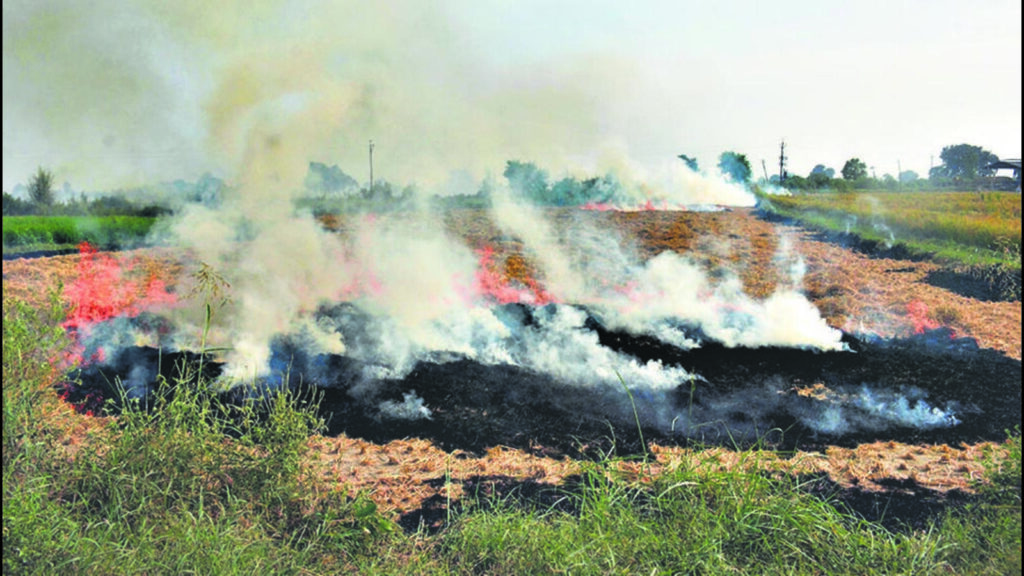Crop shift to alleviate stubble fires: CAQM tells Supreme Court | Latest News Delhi

Punjab, Haryana and Uttar Pradesh, the three states that burn the most farm stubble, have proposed to shift more than 500,000 hectares where they grow non-Basmati rice to alternative crops such as maize, sugarcane and cotton, as part of a plan to minimise the fires that cause an air pollution emergency in north India every winter, the Supreme Court has been informed.

The action plans by the three states formed part of a consolidated report filed in the Supreme Court by the Commission for Air Quality Management (CAQM), a central agency tasked with weeding out pollution in the National Capital Region (NCR).
The commission, following a series of meetings with the state authorities, collated the responses from the three states to chart out an action plan ahead of the paddy sowing season that begins in Punjab every May.
Punjab, which cultivated paddy over 3.15 million hectares in 2024, generated 19.52 million tonnes of stubble that year.
Haryana, with a paddy cultivation of 1.57 million hectares that year, contributed 8.10 million tonnes of stubble residue.
The regions of Uttar Pradesh that fall within NCR generated 0.74 million tonnes of stubble over 185,000 hectares of cultivation.
The states, in the report filed on March 24, also said they will take a bunch of other measures to wean out farm fires, including eliminating stubble on site and pushing the use of stubble in industries or as animal fodder.
The report was tabled in a public interest litigation (PIL) filed by advocate and activist MC Mehta dealing with steps to control pollution in Delhi-NCR. The court identified a slew of contributors to pollution, including industrial sources, vehicular sources, dust, waste burning, firecrackers and stubble fires, and decided to deal with each cause to reduce pollution in the Capital.
Cities across NCR are cloaked in a sheet of filthy grey ahead of winter every year, with pollution levels in the deep-red “severe” zone of the air quality index (AQI) for days on end. The worst period coincides with the onset of winter and the harvest season and, for three to four weeks, the index stays in the “severe” category, driven primarily by smoke from burning paddy fields in Punjab and Haryana, where cultivators set their plots alight to prepare for the winter harvest.
The case will now be heard on April 3.
In its report, CAQM said, “To reduce dependence on paddy cultivation, Punjab is promoting maize as an alternative for ethanol production.” There are 18 grain-based distilleries in the state producing ethanol. A total of 459,000 hectares in the state will be diversified to grow kharif crops including maize, sugarcane and cotton, CAQM submitted.
Haryana too will replace paddy across 81,000 hectares with other crops, which it did not specify.
The state said it will shorten the time for paddy harvest by going for ‘Direct Seeding of Rice’ to ensure the crop is cut before the winter months, beginning October. Uttar Pradesh shared an ‘Accelerated Maize Development Programme’ plan to shift to crops other than paddy across 11,000 hectares in 2025.
In February, the court directed CAQM to meet representatives from the three states and prepare an action plan to ensure the pollution load in the Capital due to stubble fires is reduced.
Punjab told the court that it was open to crop diversification, but warned that it would be difficult to convince farmers to switch. The state said that if maize is grown, farmers need to be convinced about a minimum support price (MSP) and assured procurement.
Paddy, on the other hand, is procured by the Food Corporation of India.
The state’s action plan, however, claimed officials had made some progress on convincing farmers to switch to maize.
The court took up the CAQM report last week but is yet to examine the suggestions in it.
The top court began monitoring the issue of pollution in Delhi in 1985 in a public interest litigation filed by environmental activist and lawyer MC Mehta. It was only in 2017, the top court decided to turn its focus on crop burning and asked the Centre to do something about it. By November 2019, court ordered a complete stop on stubble fires holding the state administration and police liable for inaction for each single violation of court order.
A bench headed by justice Abhay S Oka took the report on record along with the suggestions given by CAQM to enhance enforcement and monitoring mechanism to prevent stubble fires. The commission recommended inspection teams to be constituted in the evening after several farmers set fields alight when satellite radars mapping stubble fires were inactive.
Senior advocate Aparajita Singh assisting the court as amicus curiae submitted last week that while CAQM has provided suggestions, it should also fix responsibility on the officers supposed to implement the suggestions to ensure better accountability and smooth enforcement of action plan. The court is expected to hear the matter next month.




